
The feathertail glider, also known as the pygmy gliding possum, pygmy glider, pygmy phalanger, flying phalanger and flying mouse, is a species of marsupial native to eastern Australia. It is the world's smallest gliding mammal and is named for its long feather-shaped tail.
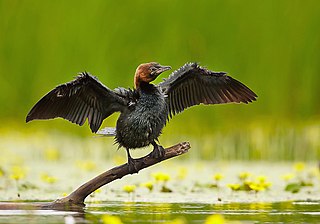
The pygmy cormorant is a member of the Phalacrocoracidae (cormorant) family of seabirds. It breeds in south-eastern Europe and south-western Asia. It is partially migratory, with northern populations wintering further south, mostly within its breeding range. It is a rare migrant to western Europe.

The royal antelope is a West African antelope recognized as the world's smallest. It was first described by Swedish zoologist Carl Linnaeus in 1758. It stands up to merely 25 cm (10 in) at the shoulder and weighs 2.5–3 kg (5.5–6.6 lb). A characteristic feature is the long and slender legs, with the hindlegs twice as long as the forelegs. Horns are possessed only by males; the short, smooth, spiky horns measure 2.5–3 cm (0.98–1.18 in) and bend backward. The soft coat is reddish to golden brown, in sharp contrast with the white ventral parts. In comparison to Bates's pygmy antelope, the royal antelope has a longer muzzle, broader lips, a smaller mouth and smaller cheek muscles.
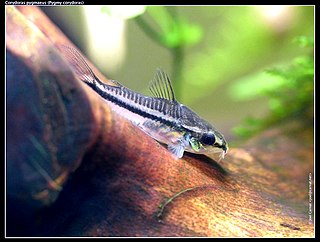
Corydoras pygmaeus, or the pygmy corydoras or pygmy catfish is a tropical and freshwater fish belonging to the subfamily Corydoradinae of the family Callichthyidae. It originates in tropical inland waters in South America, and is found in the Madeira River basin in Brazil.

The pygmy slow loris is a species of slow loris found east of the Mekong River in Vietnam, Laos, eastern Cambodia, and China. It occurs in a variety of forest habitats, including tropical dry forests, semi-evergreen, and evergreen forests. It was originally classified within Nycticebus until it was transferred to the genus Xanthonycticebus in 2022. Two species are recognised, the northern pygmy loris X. intermedius from northern Vietnam, Laos and China and the southern pygmy loris X. pygmaeus from southern Vietnam, Laos and Cambodia. The animal is nocturnal and arboreal, crawling along branches using slow movements in search of prey. Unlike other primates, it does not leap. It lives together in small groups usually with one or two offspring. An adult can grow to around 19 to 23 cm long and has a very short tail. It weighs about 450 g (1.0 lb). Its diet consists of fruits, insects, small fauna, tree sap, and floral nectar. The animal has a toxic bite, which it gets by licking a toxic secretion from glands on the inside of its elbows. The teeth in its lower jaw form a comb-like structure called a toothcomb that is used for scraping resin from tree bark.
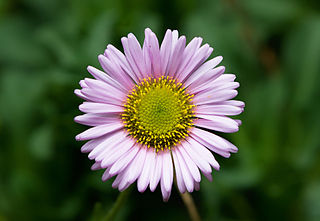
Astereae is a tribe of plants in the family Asteraceae that includes annuals, biennials, perennials, subshrubs, shrubs, and trees. They are found primarily in temperate regions of the world. Plants within the tribe are present nearly worldwide divided into over 250 genera and more than 3,100 species, making it the second-largest tribe in the family behind Senecioneae.

The pygmy three-toed sloth, also known as the monk sloth or dwarf sloth, is a species of sloth in the family Bradypodidae. The species is endemic to Isla Escudo de Veraguas, a small island off the Caribbean coast of Panama. The species was first described by Robert P. Anderson of the University of Kansas and Charles O. Handley Jr., of the Smithsonian Institution in 2001. The pygmy three-toed sloth is significantly smaller than the other three members of its genus, but otherwise resembles the brown-throated three-toed sloth. According to Anderson and Handley Jr., the head-and-body length is between 48 and 53 centimetres, and the body mass ranges from 2.5 to 3.5 kg.

Idiosepius pygmaeus, also known as the two-toned pygmy squid, Tropical Pygmy squid, is a species of bobtail squid native to the Indo-Pacific. It occurs in waters of the South China Sea, Japan, Philippines, Palau, Indonesia, Northern Mariana Islands, as well as northern and northeastern Australia. It inhabits shallow, inshore waters.

The Philippine pygmy roundleaf bat, also called the Philippine pygmy leaf-nosed bat, is a species of bat in the family Hipposideridae. It is endemic to the Philippines, where it has been recorded on Bohol, Luzon, Marinduque, Negros, Panay, and Mindanao.

Erigeron pygmaeus is a species of flowering plant in the family Asteraceae known by the common name pygmy fleabane, or pygmy daisy.

Stenotus is a genus of flowering plants in the family Asteraceae. There are four species, all native to western North America. They are known commonly as mock goldenweeds.
Tonestus, common name serpentweed, is a genus of North American flowering plants in the family Asteraceae.
Triniteurybia aberrans, the Idaho goldenweed, is a species of flowering plant in the tribe Astereae within the family Asteraceae. It is the only species in the genus Triniteurybia.

Leptosiphon pygmaeus is a species of flowering plant in the phlox family known by the common name pygmy linanthus.
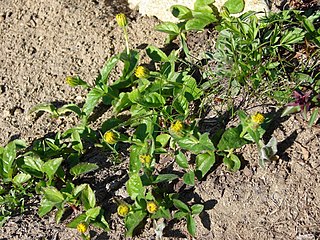
Tonestus lyallii is a species of flowering plant in the family Asteraceae known by the common names Lyall's goldenweed, Lyall's serpentweed and Lyall's tonestus. It is native to western North America, particularly in the Rocky Mountains and the mountain ranges of the Pacific Northwest with scattered occurrences between. It is a perennial herb growing in clumps or short bunches not more than about 15 centimeters tall, the stem branching from a tough caudex. The leaves are smooth-edged and linear or lance-shaped, the largest at the base of the plant reaching up to about 8 centimeters long. The inflorescence is a single flower head or a pair of heads each about a centimeter wide with green or red phyllaries. The head bears at least 10 or 11 bright yellow ray florets around a center containing many tubular disc florets.
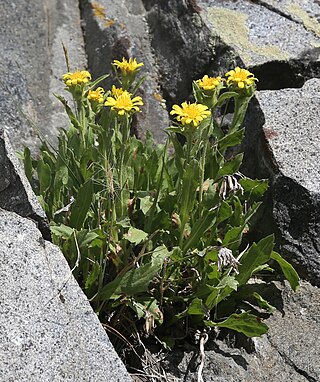
Tonestus peirsonii is a local-endemic species of flowering plant in the family Asteraceae known by the common names Inyo tonestus, Peirson's serpentweed and Peirson's tonestus.
Toiyabea alpina, the alpine serpentweed, is a species of North American plants in the tribe Astereae within the family Asteraceae. It is native to the Toiyabe and Toquima Mountains of central Nevada.
Toiyabea granitica, common names granite serpentweed and Lone Mountain serpentweed, is a rare endemic plant species known only from the east side of Lone Mountain in Esmeralda County, Nevada, about 20 km west of Tonopah. It grows there in the crevices of granitic outcrops.

Eurybia kingii is a North American species of flowering plants in the family Asteraceae, called the King's serpentweed or King's aster. It has been found only in the State of Utah in the western United States.
















